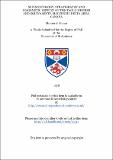Files in this item
Sedimentology, stratigraphy and diagenetic history of the taglu member and equivalents, MacKenzie delta area, Canada
Item metadata
| dc.contributor.advisor | Walton, K. E. | |
| dc.contributor.author | Shawa, Monzer S. | |
| dc.coverage.spatial | 150 p. | en_US |
| dc.date.accessioned | 2018-07-18T14:28:55Z | |
| dc.date.available | 2018-07-18T14:28:55Z | |
| dc.date.issued | 1978 | |
| dc.identifier.uri | https://hdl.handle.net/10023/15541 | |
| dc.description.abstract | The Taglu is introduced as a new member of the Reindeer Formation. Its type section is in the Taglu G-33 well and its age is Eocene. This member conformably overlies the Aklak Member and underlies the "Un-named shale" or the "Kugmallit" member. The thickness of the Taglu varies from well to well but in the type section it is 800 ft. (268 m). Correlation of the Taglu Member is difficult due to facies changes, similarity in composition of successive facies, faulting, and the absence of marker beds or diagnostic fauna. Correlation, however, was accomplished through seismic interpretation, sedimentary megacycles, trace elements, biology, gamma-ray logs and logic. The Taglu Member was deposited under cool but occasionally warm temperate climatic conditions and is composed of two main deltaic sequences, each represented by a regressive phase overlain by a transgressive phase. Each sequence includes environments such as prodelta, delta front, distributary mouth bars, marshes and swamps, and finally distributary channels on top. The depositional basin during accumulation was undergoing moderate subsidence and receiving a high influx of sediments. Both the Richardson Mountains and the Eskimo Lakes Arch supplied, at least in part, the Taglu sediments. Occasional presence of volcanic rock fragments may indicate a third source, possibly well to the south. Based on its composition, the Taglu sandstone can be classified as quartz arenite and sublitharenite. It consists of quartz, chert, feldspar, mica, rock fragments, woody herbaceous matter, and cementing material. The cementing material includes non-ferroan calcite, ferroan and non-ferroan dolomite, siderite, silica and authigenic clay minerals. The cement, which is mainly controlled by the environment of deposition, is eodiagenetic and in places mesodiagenetic. | en_US |
| dc.language.iso | en | en_US |
| dc.publisher | University of St Andrews | |
| dc.subject.lcc | QE195.S5 | |
| dc.subject.lcsh | Geology--Northwest Territories--Mackenzie | en |
| dc.title | Sedimentology, stratigraphy and diagenetic history of the taglu member and equivalents, MacKenzie delta area, Canada | en_US |
| dc.type | Thesis | en_US |
| dc.contributor.sponsor | Home Oil Company | en_US |
| dc.type.qualificationlevel | Doctoral | en_US |
| dc.type.qualificationname | PhD Doctor of Philosophy | en_US |
| dc.publisher.institution | The University of St Andrews | en_US |
This item appears in the following Collection(s)
Items in the St Andrews Research Repository are protected by copyright, with all rights reserved, unless otherwise indicated.

